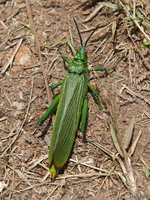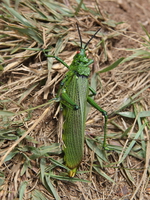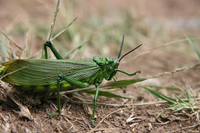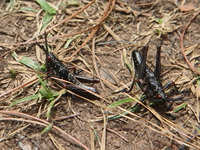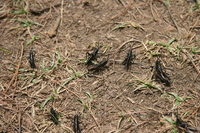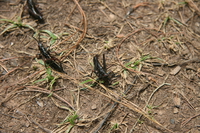hoppers
Grasshoppers have antennae that are almost always shorter than the body (sometimes filamentous), and short ovipositors. Those species that make easily heard noises usually do so by rubbing the hind femurs against the forewings or abdomen (stridulation), or by snapping the wings in flight. Tympana, if present, are on the sides of the first abdominal segment. The hind femora are typically long and strong, fitted for leaping. Generally they are winged, but hind wings are membranous while front wings (tegmina) are coriaceous and not fit for flight. Females are normally larger than males, with short ovipositors.
They are easily confused with the other sub-order of Orthoptera, Ensifera, but are different in many aspects, such as the number of segments in their antennae and structure of the ovipositor, as well as the location of the tympana and modes of sound production. Ensiferans have antennae with at least 30 segments, and caeliferans have fewer. In evolutionary terms, the split between the Caelifera and the Ensifera is no more recent than the Permo-Triassic boundary (Zeuner 1939).
The grasshopper's reproductive system consists of the gonads, the ducts which carry sexual products to the exterior, and accessory glands. In males, the testes consist of a number of follicles which hold the spermatocytes as they mature and form packets of elongated spermatozoa. After they are liberated in bundles, these spermatozoa accumulate in the vesicula seminalis (vas deferens).
In females, each ovary consists of ovarioles. These converge upon the two oviducts, which unite to create a common oviduct which carries ripe eggs. Each of the ovarioles consists of a germarium (a mass of cells that form oocytes, nurse cells, and follicular cells) and a series of follicles. The nurse cells nourish the oocytes during early growth stages, and the follicular cells provide materials for the yolk and make the eggshell (chorion).
During reproduction, the male grasshopper introduces sperm into the ovipositor through its aedeagus (reproductive organ), and inserts its spermatophore, a package containing the sperm, into the female's ovipositor. The sperm enters the eggs through fine canals called micropyles. The female then lays the fertilized egg pod, using her ovipositor and abdomen to insert the eggs about one to two inches underground, although they can also be laid in plant roots or even manure. The egg pod contains several dozens of tightly-packed eggs that look like thin rice grains. The eggs stay there through the winter, and hatch when the weather has warmed sufficiently. In temperate zones, many grasshoppers spend most of their life as eggs through the "cooler" months (up to 9 months) and the active states (young and adult grasshoppers) live only up to three months. The first nymph to hatch tunnels up through the ground, and the rest follow. Grasshoppers develop through stages and progressively get larger in body and wing size. This development is referred to as hemimetabolous or incomplete metamorphosis since the young are rather similar to the adult.
Grasshoppers are herbivorous insects of the suborder Caelifera in the order Orthoptera. To distinguish them from bush crickets or katydids, they are sometimes referred to as short-horned grasshoppers. Species that change color and behaviour at high population densities are called locusts.
The digestive system of grasshoppers includes a foregut (stomodaeum - the mouth region), a hindgut (proctodaeum - the anal region), and a midgut (mesenteron). The mouth leads to the muscular pharynx, and through the esophagus to the crop. This discharges into the midgut, which leads to the malpighian tubules. These are the chief excretion organs. The hindgut includes intestine parts (including the ileum and rectum), and exits through the anus. Most food is handled in the midgut, but some food residue as well as waste products from the malpighian tubules are managed in the hindgut. These waste products consist mainly of uric acid, urea and a bit of amino acids, and are normally converted into dry pellets before being disposed of.
The salivary glands and midgut secrete digestive enzymes. The midgut secretes protease, lipase, amylase, and invertase, among other enzymes. The particular ones secreted vary within the different diets of grasshoppers.
The grasshopper's nervous system is controlled by ganglia, loose groups of nerve cells which are found in most species more advanced than cnidarians. In grasshoppers, there are ganglia in each segment as well as a larger set in the head, which are considered the brain. There is also a neuropile in the centre, through which all ganglia channel signals. The sense organs (sensory neurons) are found near the exterior of the body and consist of tiny hairs (sensilla), which consist of one sense cell and one nerve fiber, which are each specially calibrated to respond to a certain stimulus. While the sensilla are found all over the body, they are most dense on the antennae, palps (part of the mouth), and cerci (near the posterior). Grasshoppers also have tympanal organs for sound reception. Both these and the sensilla are linked to the brain via the neuropile.

